Camera and lens choices on 12 Aussie titles in 2021
Cinematographers from local television, feature, online and documentary titles explain the decisions behind their camera and lens packages.
Australian titles in 2021 gave audiences yet another visual and tonal feast, from television dramas that transported viewers back to 1800s and 1980s, to underwater documentaries with ground-breaking technology, TikTok series that navigated vertical frames yet never compromised on quality, and breath-taking feature films that competed to acclaim on the world stage.
Below, hear from Australian cinematographers and directors of photography about the cameras and lenses they chose, and why.
Not sure of some terms? Find a cheat sheet at the end of the article.
(In alphabetical order of titles)
Cinematographer: Shing Fung Cheung
Director: Bjorn Stewart
Filmed on RED Dragon X with Celere HS prime lenses and a Mōvi gimbal and Easyrig
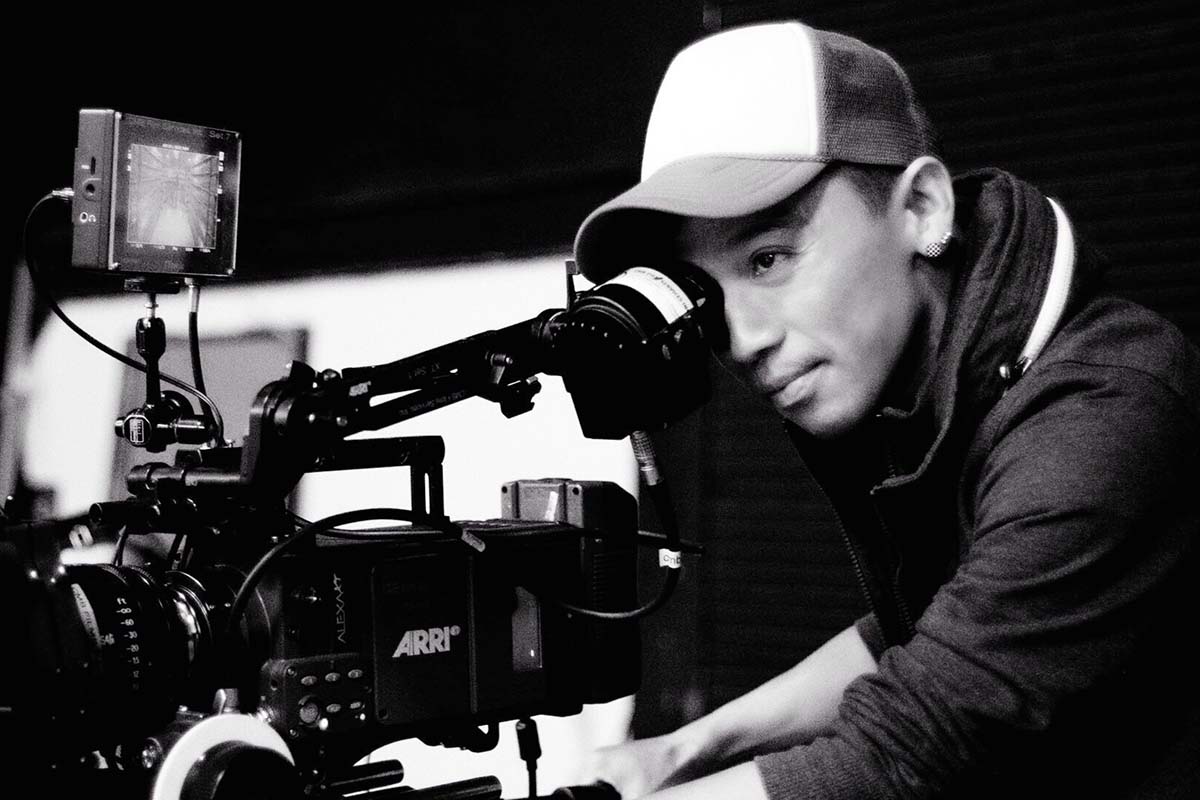 Shjing Fung Cheung
Shjing Fung Cheung
Created by Enoch Mailangi, who wrote the 5 x 15 minute series with writer Kodie Bedford, All My Friends Are Racist took home Best Short Form Comedy at the 2021 AACTA Awards. It follows BFF’s Casey (Davey Thompson) and Belle (Tuuli Narkle) who call out their circle of friends in Brisbane as racists but end up getting cancelled themselves. Read more about how it was made here
Shing Fung Cheung: All My Friends Are Racist is a series aimed at younger audiences with "larger than life" characters. During early conversations with director Bjorn Stewart, I learnt he wanted dynamic shots, exaggerated camera angles and energetic camera movements so a lot of it would be done on the gimbal. I needed a light-weight camera that has good colour science, so I chose RED. A lot of shots in the series would be done on the Mōvi gimbal Rig and our gimbal operator Declan Sinclair owns a RED Dragon X as well, so that's the package we decided to use. With the RED camera on the Mōvi attached to an Easyrig, we were able to achieve creative camera movements and the camera was also freed up for some dynamic blocking. I believe it was also about the speed: we had to achieve a lot of screen time every day and this setup also allowed us to move quickly and incorporate camera movements into our shots without having to take time to set tracks. For lenses, I used Celere Primes lenses because I love the look of them: I think their softness goes really well with the sharpness of RED cameras. They have special characteristics that I like, such as the way they flare and how their highlights tend to have a smoother roll off. A big advantage also is all of the five Prime lenses in the set weigh more or less the same – it is very handy when you shoot with a gimbal that you do not have a do a major re-balance every time you change a lens, also a crucial factor when you are on a tight schedule.
Watch All My Friends are Racist on ABC iview.
Cinematographer: Joanne Donahoe-Beckwith
Directors: Kitty Flanagan, Tom Peterson
Filmed on 2 x ARRI Alexa Mini with T2.9 Cabrio zooms (full camera package below)
2 x Arri Alexa Mini
2 x 19-90mm T2.9 Cabrio zooms
1 x 85-300 T2.9 Cabrio Cinema zoom
1 x set canon Sumire CN-E Prime lens kit package 14mm, 20mm, 24mm, 35mm, 50mm, 85mm, 135mm
1 x Ronin Mk2
2 x Easyrigs
A truck load of monitors, transmitters, receivers and cables to accommodate the separate viewing bubbles.
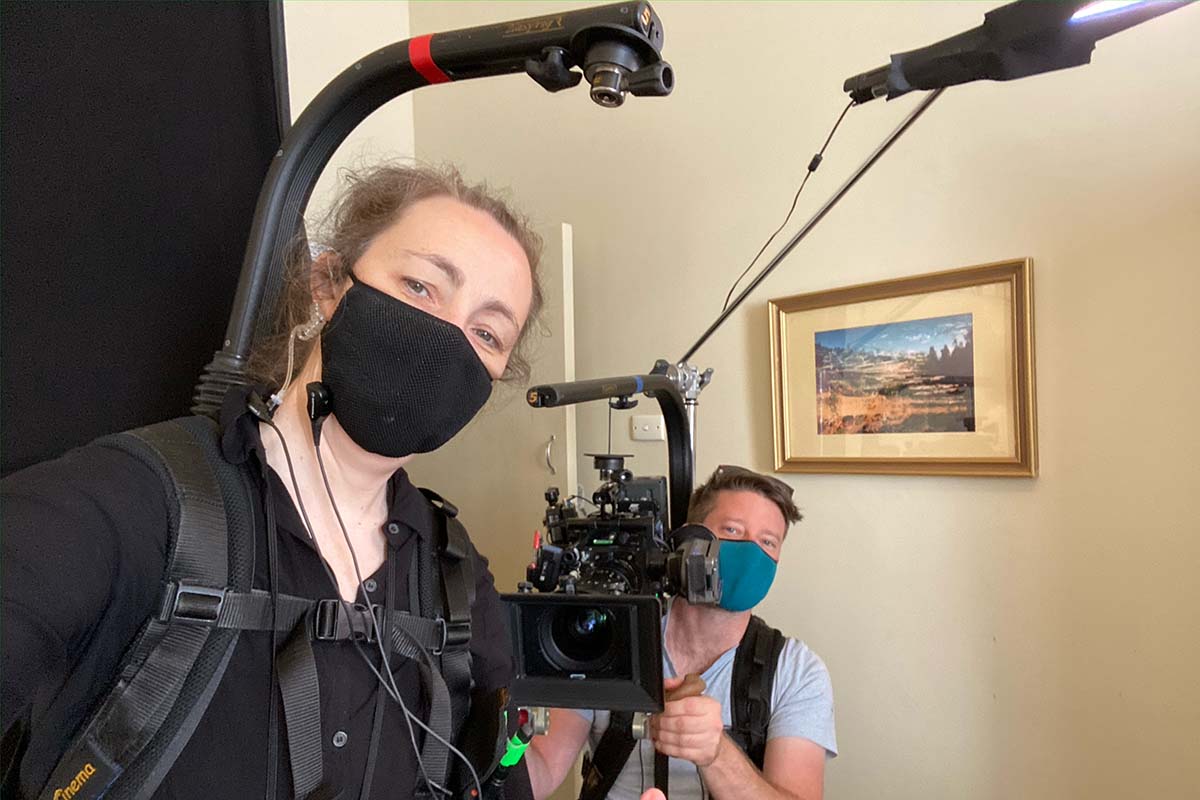 DOP-A Camera Operator Joanne Donahoe-Beckwith and B Camera Operator Andrew Ware on set for Fisk
DOP-A Camera Operator Joanne Donahoe-Beckwith and B Camera Operator Andrew Ware on set for Fisk
Created, co-written, co-directed and starring Australian comedy great Kitty Flanagan, Fisk follows Helen Tudor-Fisk, a contracts lawyer who loves her dog Artie and a brown suit, but isn’t what you would call a ‘people person’. When her life falls apart, she takes a job at a Melbourne firm specialising in wills and probate. Winner of the 2021 AACTA Awards for Best Narrative Comedy Series and Best Comedy Performer, a second season is already in the pipeline.
Joanne Donahoe-Beckwith: The camera package for Fisk on the surface seems pretty simple and basic, we had already landed on cross camera coverage to preserve comedy performance, but arriving at the final list was anything but basic.
Co-directors Kitty Flanagan and Tom Peterson are dream creative collaborators and involved me in exploring ‘warm, worn and brown’, which sums up the look and feel of the series. The ability to both hero and separate colours so close to skin tones and ‘that brown suit’ and brown dressings was vital. For this reason, the Alexa Mini was the tool for the job. I love the authenticity of its colour space with skin tones, so I could trust my eye. Landing on the lens package was a bit of a journey, as zooms were not initially on the radar as our key lenses. I had romantic notions of using a prime lens package, unfortunately that had to change. The restrictions that came into effect in Melbourne that allowed us to emerge from lockdown meant we had to forgo a traditional grip department. Our safety protocols stipulated one person per four metres for useable space and this meant any furniture in a room was deducted from the measurements of a space. Sliders and dollies and crew requirements literally impacted the number of people in a room. And so the idea of using the zoom as more of an on-screen tool developed. We are taught to not draw attention to the camera in service of the performance, but we broke that rule. It became a tool to enhance the comedy and performances.
Mastering the speed of on-screen zoom was basically dictated by the actor and reading their reactions, learning their lines and those subtle tells that you come to recognise as an operator. It might be an intake of breath, a slight head move but you learn fast to shoot fast. And of course having a zoom stick at the ready. Finding the right zoom lenses included the criteria of flattering bokeh, shallow depth of field when wide, no elemental loss of light when zooming, covering our ‘hero’ range of sizes in one zoom and imperceptible breathing. I tested quite a few combinations. The Cabrio won the day and stayed at T2.9 the whole shoot.
My privileged access to onset comedy master classes with the Working Dog team over the years and having worked with Kitty on four series of Utopia meant there was already a level of trust and understanding when it came to working together and developing our working style. Of course the look still requires a team to mould it, from lighting, camera, art department, costume, hair and make-up and the grade. This show was the sum of its parts that had to work very closely and I will never look at brown the same way again after this experience!
Watch Fisk on ABC iview.
Cinematographer: Mark Broadbent ACS
Director: Dean Gibson
Filmed on 2 x Canon C500ii with Cinescope TLS Leica R Primes
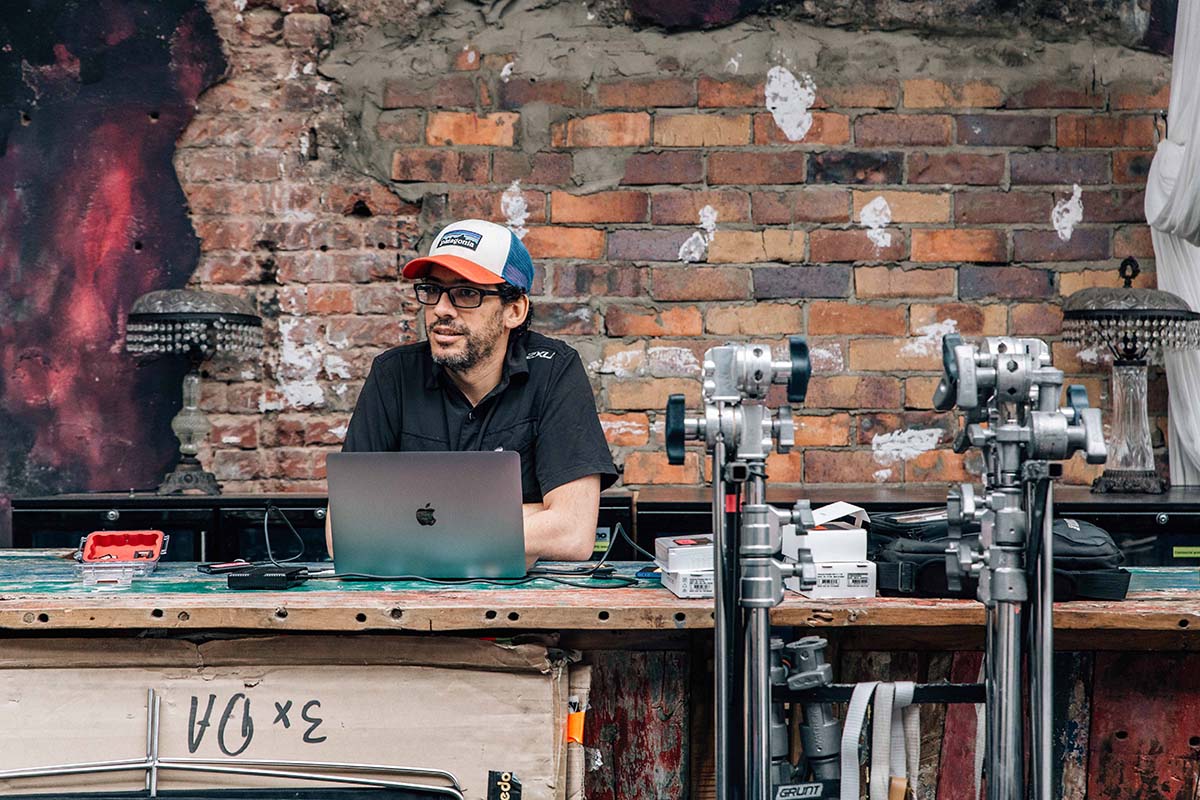 Mark Broadbent ACS on set for Incarceration Nation (Photo credit: Claudine Thornton)
Mark Broadbent ACS on set for Incarceration Nation (Photo credit: Claudine Thornton)
A feature-length documentary special from First Nations director Dean Gibson and NITV, which aired as part of SBS’ Australia Uncovered series as well as screening at Sydney Film Festival. Incarceration Nation looks at the key drivers of the incarceration of First Nations people – who make up 29% of the prison population, and yet 3.3% of the population. First Nations experts including Judge Matthew Myers, barrister Joshua Creamer, Associate Professor Chelsea Bond, Professor Don Weatherburn and lawyer Teela Reid offer insights, tracing this oppression back to colonial times, and reveal paths forward.
Mark Broadbent ACS: From early discussions with director Dean Gibson we decided we wanted to shoot the interviews on two cameras to give him a variety of frames in the edit. I had used the Canon C500ii on a couple of projects leading up to the shoot and had found it a great all-rounder in terms of size, versatility and most importantly image quality. I had also wanted to shoot on a full frame sensor to give a greater sense of depth with wider frames in the interviews. Another aspect we needed to consider with camera choice was data. With the length and number of interviews we needed a camera that was reasonably economical on data without compromising the image and the XF-AVC codec ticked this box.
For lenses I chose to work with a kit of rehoused Leica R primes. It is a set I’ve used for a number of years and find them a great balance by being quite sharp but also having some character that leans towards the feel of “vintage” glass without the compromises often associated with using older lenses. The interviews were shot on the 35mm and 90mm while the observational shoots where primarily the 35mm and 50mm.
Watch Incarceration Nation on SBS on Demand.
Cinematographer: Matthew Temple
Director: Corrie Chen
Filmed on ARRI Alexa Mini with Genesis G-35 Vintage 66 lenses by Gecko-Cam
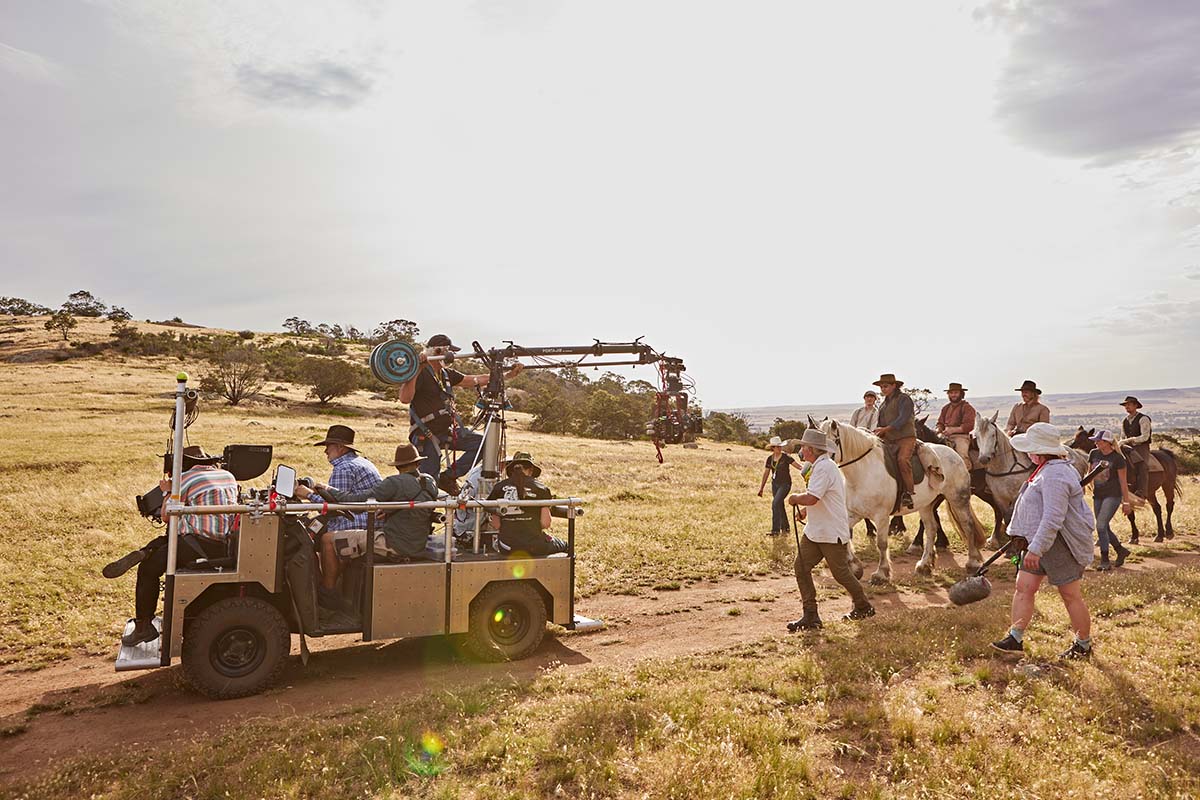 Crew on set for New Gold Mountain
Crew on set for New Gold Mountain
In critically acclaimed revisionist western New Gold Mountain, the discovery of the body of a white woman on the doorstep of the Chinese camp becomes the jumping off point for a mystery that unravels across the epic four-part series. Hear from director Corrie Chen about the making of the series here, and from composer Caitlin Yeo here
Matthew Temple: The camera and lens choices I made when shooting New Gold Mountain were influenced by three things. My intention to shoot in the most naturalistic way possible, taking into account the physical demands of the shoot and the network’s technical deliverables. Knowing the physical demands we were about to encounter on New Gold Mountain, I wanted a reliable camera that was lightweight and wasn’t power hungry. The ARRI Alexa Mini was my choice of camera. Prior to shooting, colourist Adrian Hauser and I created a show LUT (in camera look) to import into the Alexa, taking advantage of the fabulous ARRI sensor and showcasing the extraordinary sets, costumes and makeup of our world.
I shot this series using as much natural light as possible and whenever I used artificial light I tried to keep its effect broad and “uncontrollable” as if I was still dealing with the natural elements, letting “happy accidents” of light occur. This naturalistic approach influenced my choice of lenses too. I like to work with prime lenses almost exclusively as I believe it makes you consider every shot really carefully and promotes a discipline to coverage. It’s also great to be able to choose a set of lenses appropriate to the look of each project. I was keen to try the new Genesis G-35 Vintage 66 lenses by Gecko-Cam in Germany. Created with a retro look in mind they have no coating on the front element and single coating on some of the internal elements. As a result the lenses are given to attractive lens flares and subtle blooming of highlights. They lend a softness to the picture whilst remaining technically sharp. They’re also fast, with a stop of T1.4 across much of the range. During pre-production I tested them in the bush we would be filming in. I was drawn to their look and attitude and I knew they would suit my approach to this project perfectly. I’m very happy with my camera and lens package on New Gold Mountain and reckon it helped bed our story in 1857 Ballarat. I’m grateful to VA Digital Hire for their support.
Watch New Gold Mountain on SBS on Demand.
Cinematographer: Earle Dresner ACS
Director: Emma Freeman
Filmed on ARRI Alexa Mini with Panavision PVintage Primes and Panavision zooms and a Betacam SP Video Camera
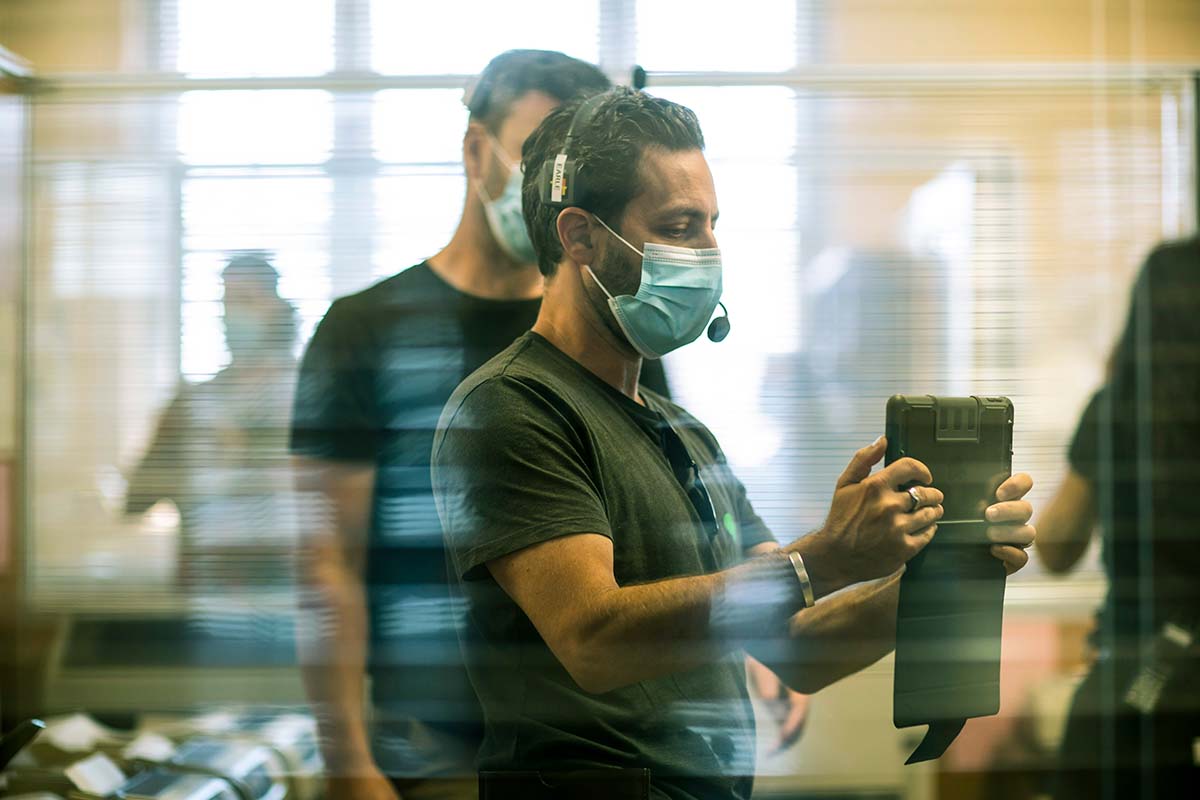 Earle Dresner ACS on set for The Newsreader
Earle Dresner ACS on set for The Newsreader
The six-part ABC TV drama swept up at the 2021 AACTAs, winning five awards including Best Drama Series. Set in the pressurised world of broadcast television in 1986, its story of ambitious reporter Dale Jennings (Sam Reid) and the station’s notoriously ‘difficult’ star newsreader Helen Norville (Anna Torv) plays out against the backdrop of real events, including Halley’s Comet and the Challenger explosion. Hear from producer Joanna Werner about the making of the series here and writer/creator Michael Lucas here
Earle Dresner ACS: Early discussions about the look of The Newsreader with director Emma Freeman centred around how to create a world set in the 1980s for a modern audience. After lots of testing and experimenting with colourist CJ Dobson we decided to embrace the period and created a look that combined many of the characteristics of the films and photography of that time.
The filmic quality and softer feel of the ARRI Alexa was the ideal choice to help achieve this look with a digital camera. I shot the entire series at an ISO of 1600 and loved the quality of the noise produced by the Alexa. Panavision Melbourne supplied us with 3 bodies so one could live on the Steadicam which we used extensively. Steadicam operator Simon Harding loved the small form factor of the Alexa Mini for the benefits it gave when moving in tight spaces through narrow hallways and doors. We paired the Alexa with the Panavision PVintage lenses – rehoused ultra speeds that were designed in the 1970s and used on some of the references we loved. Diffusion filters and some post-production techniques completed the look. For the Steadicam and when shooting establishers where I wanted to add an in-camera zoom, we used Panavision’s 27-68mm and 24-275mm zoom lenses. They complemented the primes well in terms of look and I adjusted my filter package to match the softness and blooming highlights.
For the news footage seen on TV screens in the studio, office and homes, I found the oldest working broadcast camera I could get my hands on. Videocraft Melbourne supplied an early 90s Betacam camera and there was no match for the 4:3 images with all the artifacts and compression to match news footage from the time.
Watch The Newsreader on ABC iview.
Cinematographer: Germain McMicking ACS
Director: Justin Kurzel
Filmed on ARRI Alexa Mini with Panavision UltraSpeeds
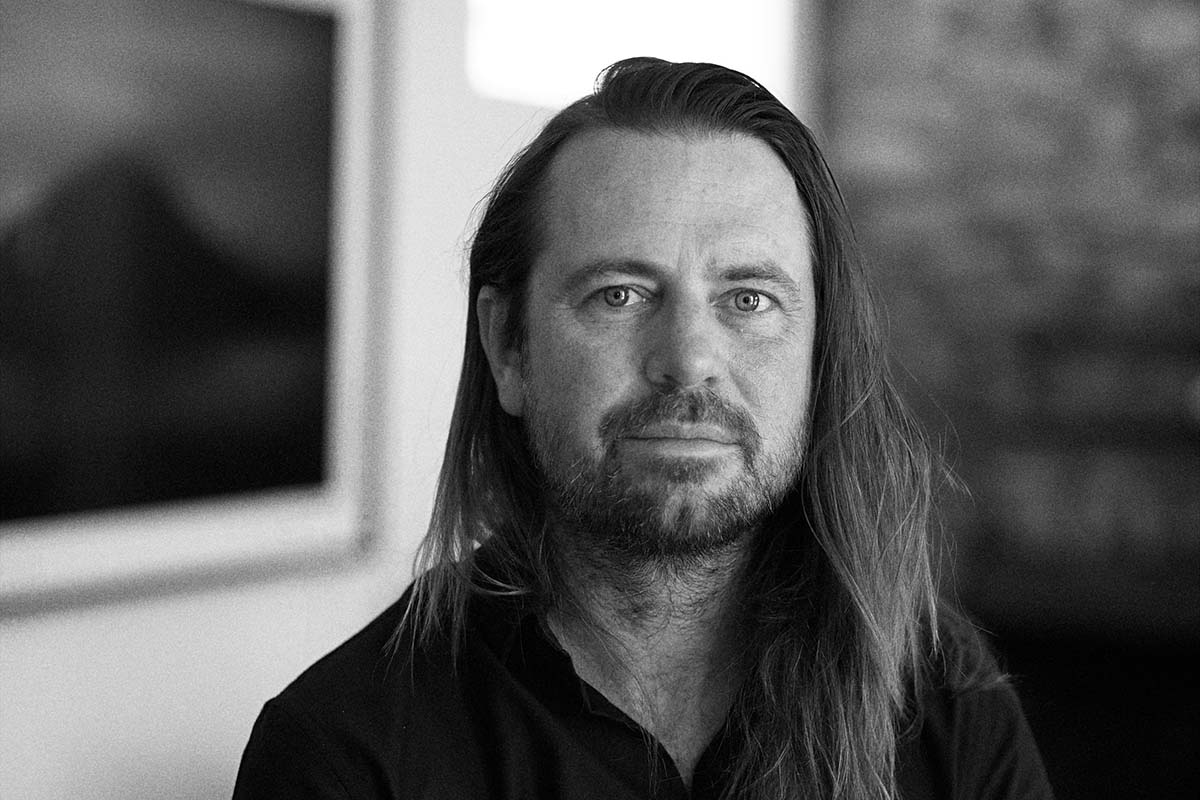 Germain McMicking ACS
Germain McMicking ACS
Nitram took home the largest haul of awards at the 2021 AACTAs, with a total of eight including Best Film and Best Direction for Justin Kurzel. It was also the winner of the CinefestOz Film Prize in 2021 and Caleb Landry Jones won Best Actor at Cannes Film Festival. The feature dramatizes the events leading up to the 1996 Port Arthur massacre in Tasmania by perpetrator Martin Bryant. It also stars Judy Davis, Essie Davis and Anthony LaPaglia.
Germain McMicking ACS: The film is in many ways a story of conflict, for the characters and audience alike. Searching to express this, Justin Kurzel wanted the film to hold both a sense of reality and fable, be both visually beautiful, roughly hewn and fragile.
Shooting mostly handheld with the small form of the Alexa Mini on spherical lenses, the camera could be physically close to the characters, and allow us to follow the performances instinctually throughout. There was a beautiful simplicity in this approach, which allowed us to very quickly react to the varying weight of each performance, and point of view. It was a constantly evolving dance, and with this exceptional cast, the experience was electric.
We poured through photographic references of 90’s Australia and began to notice how perfectly many of the suburban landscapes and interior worlds existed within the more open aspect of a 35mm stills frame. After some testing on location we settled on a similar aspect of 1.55:1. This utilised the full height and width of the Alexa sensor at OpenGate 3.4K. It’s an unusual aspect ratio for cinema, but we loved the way the format isolated and centralised the characters. The format also tended to open the frame to the space and spirits above, somehow weighting them to the earth.
We were searching for a look which would be evocative of the era, and hold a softness and texture as though it was printed on paper. We found the Panavision UltraSpeeds paired with the OpenGate Alexa sensor to be a perfect accompaniment in achieving this. The UltraSpeeds are beautiful vintage lenses from the 70’s and 80’s and had all the right textural qualities to bring a sense of nostalgia to the film.The inherent softness and character of the glass opened up the shadows, and brought some subtle halation to the highlights. We often used the UltraSpeed 50mm T1.0, as it felt right to maintain a more singular perspective throughout, and I love how this lens has so many different personalities at different apertures. When shooting wide open the lens falls apart so beautifully, and paired with the great latitude of the Alexa sensor we could let eyes almost disappear at times, and leave the audience searching.
Watch Nitram on Stan.
Cinematographer: Ari Wegner ACS
Director: Jane Campion
Filmed on ARRI Alexa LF with Panavision Ultra Panatar lenses
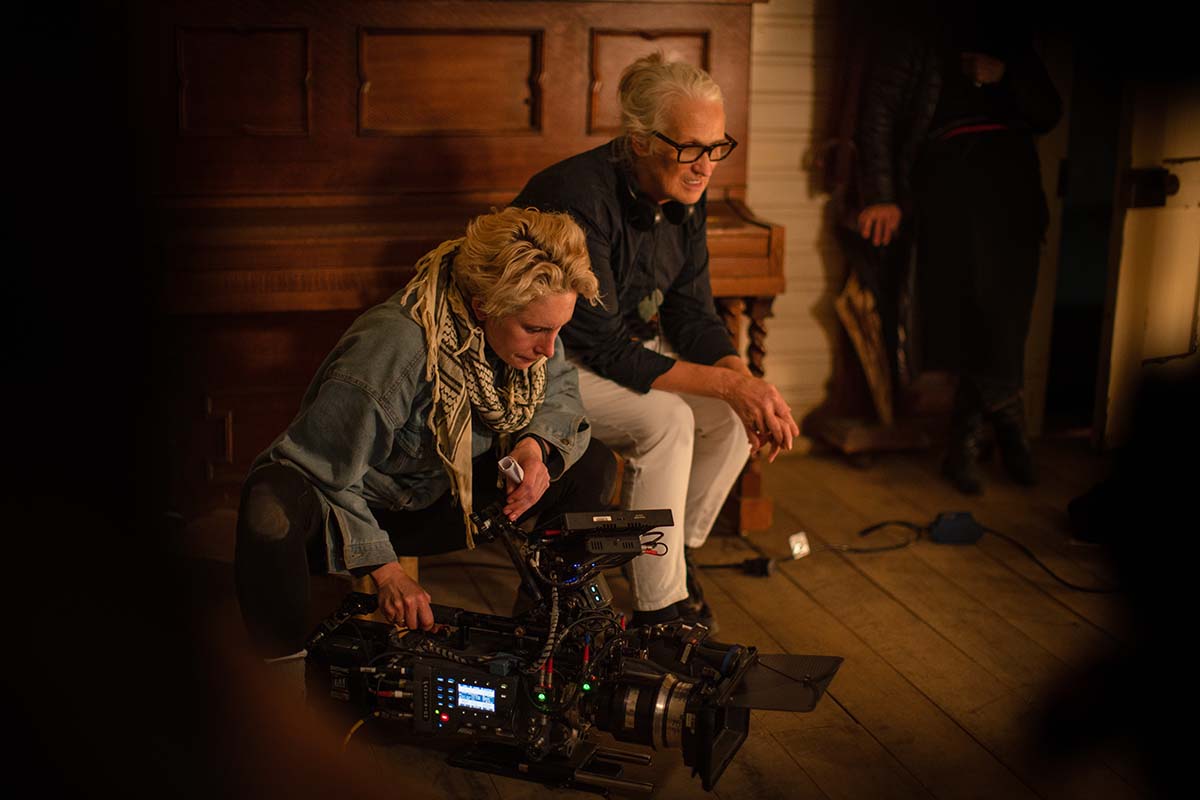 Ari Wegner ACS and Jane Campion on set for The Power of the Dog (Photo credit: Netflix)
Ari Wegner ACS and Jane Campion on set for The Power of the Dog (Photo credit: Netflix)
In 2022, Ari Wegner ACS became the second woman in history to be nominated for an Academy Award for Cinematography and the first woman to earn a BAFTA Awards cinematography nomination for her work on the Jane Campion-directed feature The Power of the Dog - a New Zealand/Australian Official Co-production. Based on the novel by Thomas Savage, The Power of the Dog is set in 1920s Montana and centres around the charismatic and domineering rancher Phil Burbank (Benedict Cumberbatch). When Phil’s brother brings home a new wife (Kirsten Dunst) and her son (Australian Kodi Smit-McPhee) to live at their sprawling property, he seems determined to wage a war of intimidation upon them, until a more surprising consequence starts to occur.
(Below excerpt lifted from the Screen Australia podcast. Listen to the full interview here)
Ari Wegner ACS: The Ultra Panatars from Panavision are 1.3x anamorphic, so some of the qualities of spherical and some of the qualities of anamorphic, which I really liked.
A lot of the film has a very controlled camera, and very precise moves in it. A very sober, non-judgemental type of photography. We also planned to have some more spontaneous work with Phil Burbank (Benedict Cumberbatch) when he was unguarded and it was definitely a dance for sure because Benedict was in character the entire time… we would often do those handheld scenes, not quite as closed sets but with less crew in the room… I try never to do handheld just because it’s quicker but for more of a stylistic reason… it allowed for a flow and spontaneity that shows through.
Watch The Power of the Dog on Netflix.
Cinematographer: Meg White ACS
Director: Steven McGregor
Filmed on 2 x ARRI Alexa mini with Panavision Ultraspeeds, Primo 19-90 and 17.5-75mm
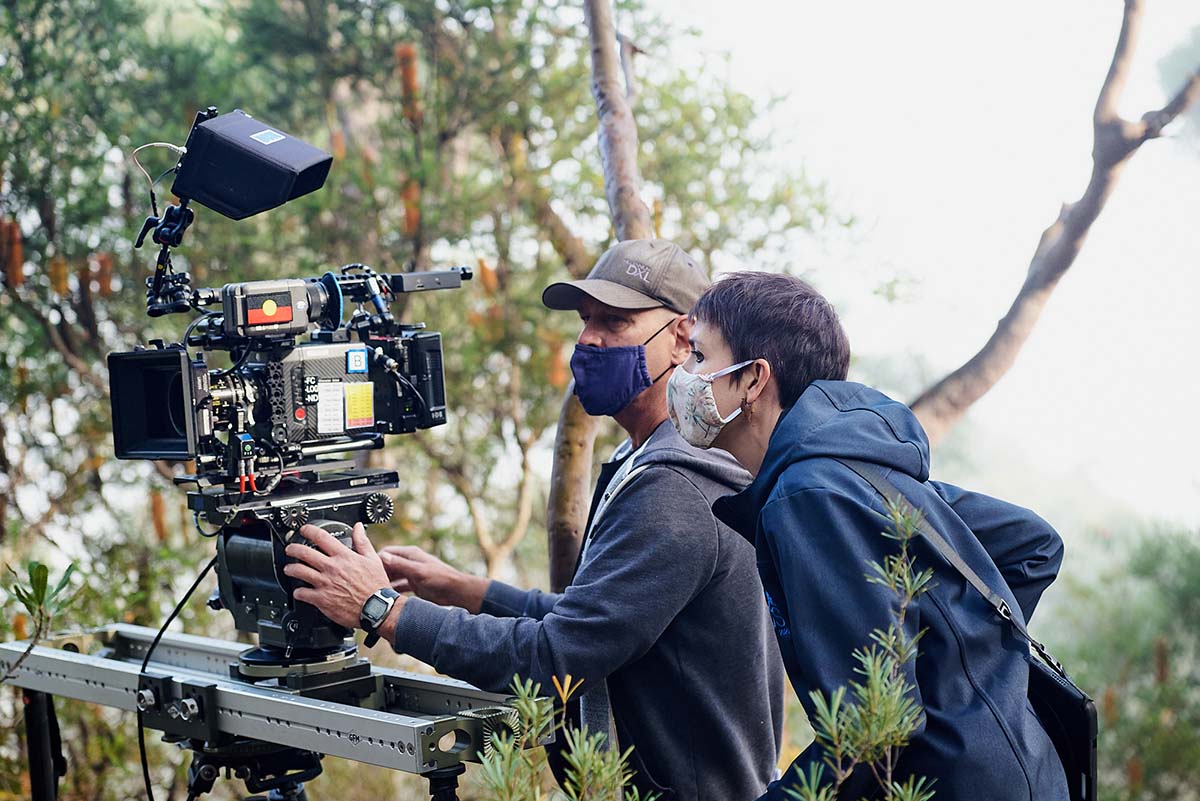 B Camera Operator Geoff Owen and Meg White ACS on set for Preppers (Photo credit: Noel Mclaughlin)
B Camera Operator Geoff Owen and Meg White ACS on set for Preppers (Photo credit: Noel Mclaughlin)
Co-created and co-written by Nakkiah Lui and Gabe Dowrick, this six-part comedy series stars Lui as Charlie, an Aboriginal woman who flees from her own personal cataclysmic event, only to find herself amongst a ragtag group of doomsday ‘preppers’. The ensemble cast includes the likes of Meyne Wyatt, Aaron McGrath, Jack Charles, Eryn Jean Norvill, Ursula Yovich and Chum Ehelepola, just to name a few. Hear more from Lui about creating Preppers here
Meg White ACS: The look of Preppers was a mix of tonal and visual references ranging from Atlanta to I Hate Suzie to Lone Star to Election. It was important the series had the fun and levity of a satire and the room to go dark when needed, as this series poked fun at colonisation whilst digging deep into the resulting trauma experienced by First Nations people. The series was predominantly shot with one full kit Ultraspeed primes (with doubles of the 50mm and 75mm) whilst the zooms were held for special occasions like the Penrith Panther music video sequence. I enjoyed the reliability of the Ultraspeeds and the distinct looks achieved at different stops, in particular the painterly quality of the bokeh when wide open. Despite the tight schedule and large (and amazing) ensemble cast, it was important to the aesthetic and landing of comedic moments that we didn't lean into the convenience of 'moving fast' with zooms. We always wanted to be tight within the axis of eye lines and the emotional experience of characters wherever possible. Handheld was only used at distinct moments and locations as production mode provided a visual control which helped elevate the underlying absurdity of the show. I was fortunate to have Geoff Owen as my B cam / steadicam on Preppers and enjoyed our collaboration on the series. Working with the talented Nakkiah Lui and delightful Steven McGregor was a highlight.
Watch Preppers on ABC iview.
Cinematographer: Pete West
Director: Nick Robinson
Filmed on RED Gemini with Laowa 24mm and the Nauticam EWML wet lens system, a custom developed macro and micro lens system and camera propulsion unit (CPU) and Canon DSLR cameras for time lapse scenes
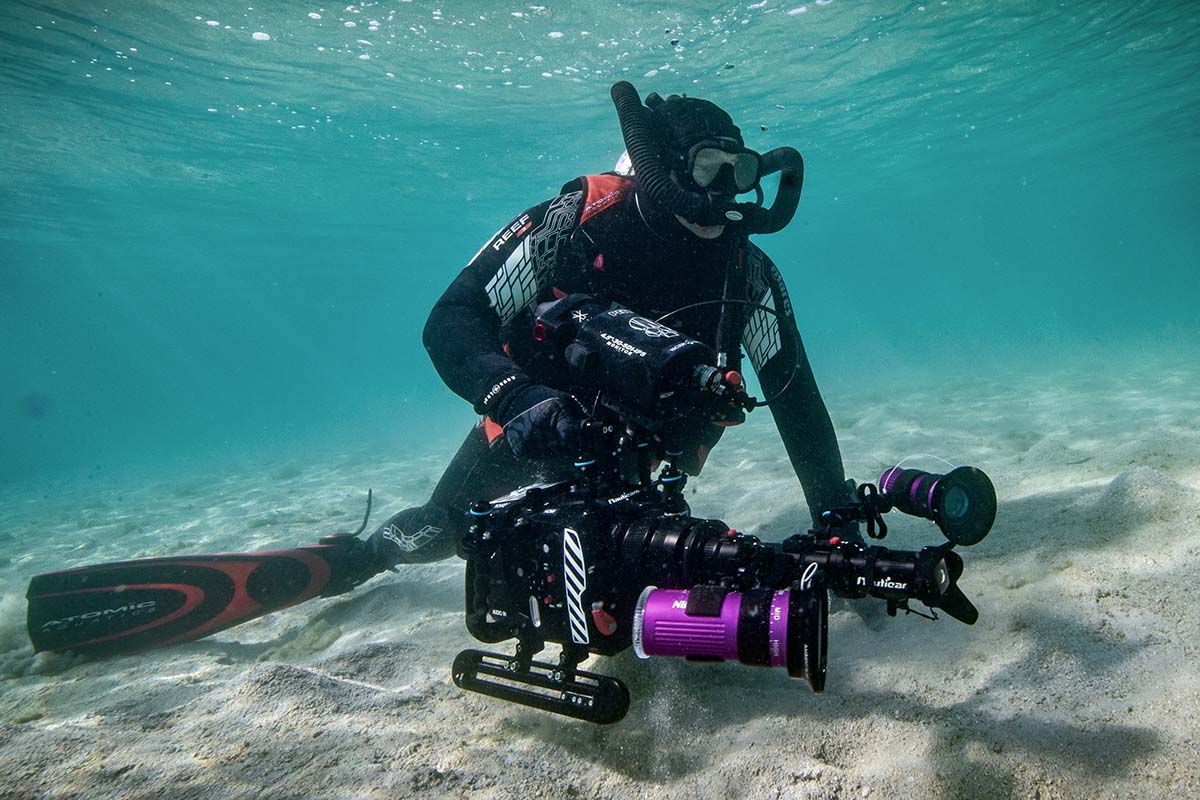 Pete West filming Puff: Wonders of the Reef
Pete West filming Puff: Wonders of the Reef
Narrated by Rose Byrne, this Netflix documentary follows a baby pufferfish as it heads off on an underwater odyssey to find a home on the Great Barrier Reef and encounters the fantastical creatures of this micro-world on his way. Queensland company BioQuest Studios developed super-macro camera techniques to capture Puff’s world up closer than ever before.
Pete West: From the beginning our aim was to produce a film showing a different perspective on a familiar subject: coral reefs. Underwater documentaries are traditionally shot using wide angle lenses in order to capitalise on their increased depth of field and reduced lighting requirements. At BioQuest Studios, our equipment and techniques have been developed to capture colour correct, high resolution images of marine organisms for science, often at super-macro and micro scales. For Puff we wanted to apply the same techniques but with an emphasis on cinematic style and movement.
We chose the RED Gemini as our principal camera because of its lower light capabilities. When working with marine animals, artificial light can not only alter their behaviour but also their physical environment when shooting in aquariums. For example, the heat generated by lights over a long period can increase water temperatures to levels that are dangerous to the animals. Many animals are also extremely light sensitive and require long periods to become accustomed to the higher light levels required for correct imaging. For some micro scenes, high intensity light was required and necessitated the use of heat absorbing filters on the light sources. The modular nature of the RED camera system is ideally suited to both our studio and underwater use and it is well supported by manufacturers of underwater housings and accessories such as Nauticam. Achieving the correct colour balance was also important and we developed a range of colour filters suitable for depths ranging from one metre in shallow sandy mangroves to more than thirty metres for some reef scenes.
To provide the audience with a sense of immersion into Puff’s world we chose to shoot many of the underwater scenes using wide-angle macro lenses such as the Laowa 24mm and the Nauticam EWML wet lens system. These lenses allowed focusing down to the glass (1:1) while maintaining acceptable wide-angle backgrounds.
For the underwater travelling scenes, we developed a new camera propulsion unit (CPU). This unit enabled us to fly the camera through the water at speeds of up to four knots.
The system uses two battery powered electric motors. Speed and direction are controlled via left and right Bluetooth handgrips. Our studio/aquarium scenes were shot with a range of macro and micro lens systems developed specifically for our work with marine research facilities. To achieve more cinematic camera moves we developed a range of multi-axis motion control systems for both studio and field use.
Time lapse scenes were shot using Canon DSLR cameras, some over weeks and some over months, many at a rate of only one frame per day.
Watch Puff on Netflix.
Cinematographer: Daniel von Czarnecki
Director: Logan Mucha
Filmed on ARRI Alexa Mini LF with Leica R Super speeds and Tiffen Black Pro Mist (1/4) filter + Vertical ND Graduated (0.6) filter
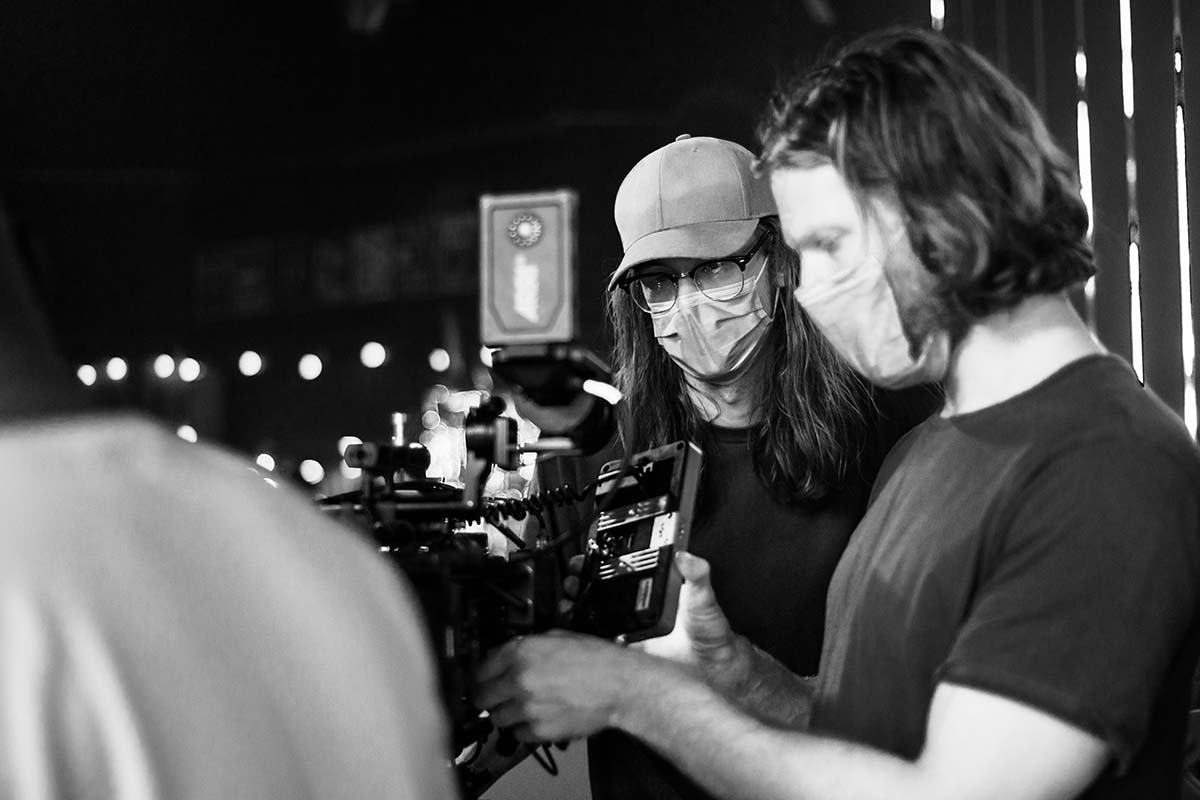 Daniel von Czarnecki on set for Scattered
Daniel von Czarnecki on set for Scattered
Co-created by Kate Darrigan and director Logan Mucha, who both served as writers alongside Adolfo Aranjuez, this 38 x 1-minute TikTok series follows three friends who wake up the day after the funeral of their friend Wil with brutal hangovers and no clue where his ashes might be. Over the course of the series, they have to retrace their steps to find Wil’s ashes and give him the send-off he deserves. Hear from Scattered producers Hayley Adams and Michelle Melky about making a series for TikTok here
Daniel von Czarnecki: Shooting for TikTok presented a unique challenge with its 9:16 composition and intrusive UI (user interface) overlays. Through early conversations with director Logan Mucha, we adapted our thinking to reframe these limitations as opportunities to explore and experiment. We quickly abandoned our go-to cinematic references and instead turned towards iconic photographers such as William Eggleston for inspiration, in particular looking at subject composition within vertical frames.
The series plays out like a road movie, with two separate timelines of events unfolding in tandem. To ensure audiences could follow these time jumps, we developed distinctive visual styles to separate the day and night sequences. Daytime was shot tighter with erratic handheld movement, injecting a sense of chaos and uncertainty. Night was instead vibrant and hyperreal, making these scenes feel like our character's memories that emphasized their emotional states over reality.
I ended up deciding to shoot on the Alexa Mini LF Open gate then cropped to 9x16 to gain a wider field of view from our selected lenses, the Leica-R's. This was imperative to creating composition within what was essentially a 7x16 frame, with the additional headroom I always had an ND 6 vertical grad in play to create texture and shape in what otherwise could have been dead space. I also worked closely with Art Director Bianca Milani to ensure the set was dressed for this unique format.
I Felt the Leica R super speeds would allow us to create both worlds remaining within a neutral and soft palette retaining natural skin tones, all the while being fast enough to employ practical sources for our night sequences. We predominantly shot on the 28 and 35mm lenses, rarely going above 50mm.
Watch Scattered on TikTok.
Cinematographer: Ashley Barron ACS
Director: Stevie Cruz-Martin
Filmed on ARRI Alexa Mini with Angenieux EZ2 series zooms and Zeiss super speeds
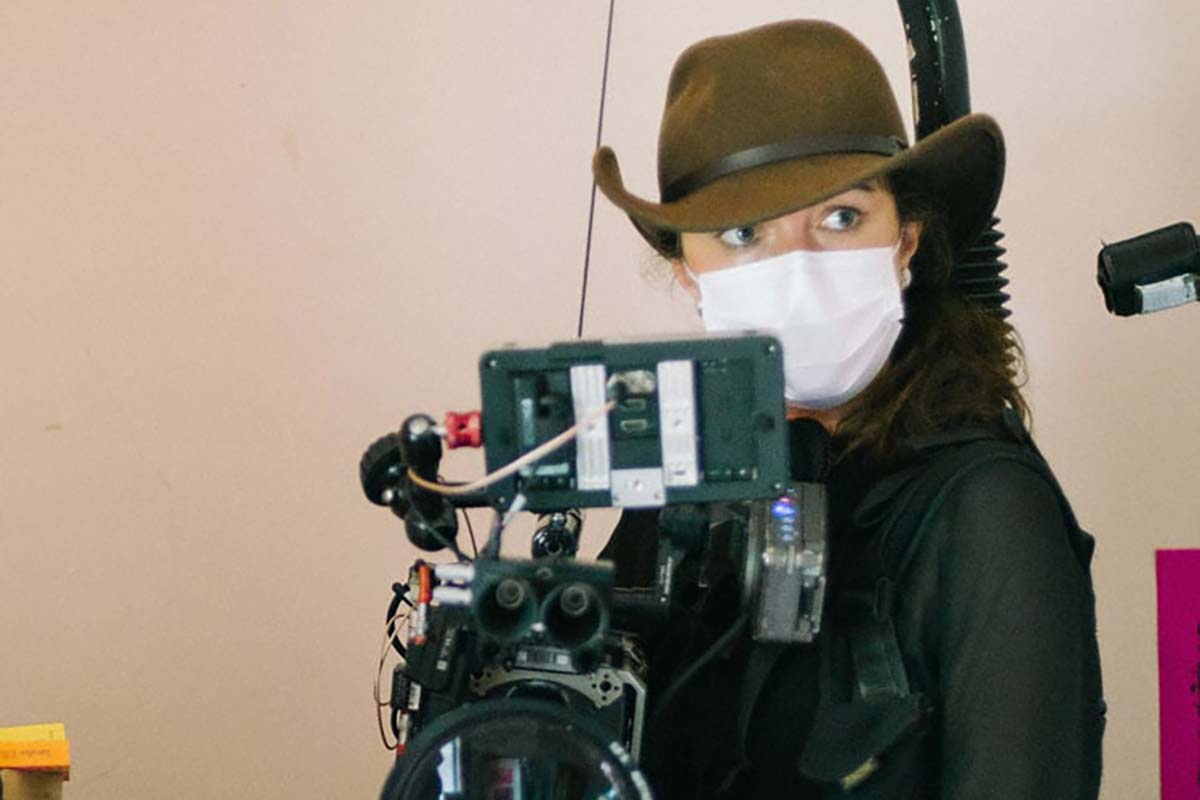 Ashley Barron ACS on set for The Tailings
Ashley Barron ACS on set for The Tailings
Winner of Best Short Form Drama at the 2021 AACTA Awards and written by Caitlin Richardson, the 6 x 10-minute series The Tailings follows teenager Jas as she goes in search of the truth about her father’s death, while her new teacher at school also harbours secrets from her past. Hear from The Tailings director Stevie Cruz-Martin here, and producer Liz Doran here
Ashley Barron ACS: We were aiming for a ‘cinematic documentary’ approach that was textured and grounded, and following tests the Alexa rated at 1280 ISO felt like the most organic choice. I knew that the Alexa's sensor would handle the 360° degree world that we’d created, and the uncontrollable situations that were thrown at us at speed. I also knew that the camera’s form factor and user features would allow me to focus more on breathing with the actors.
The zoom lenses fed into the cinematic doc approach, being a T2 for that depth of field and thus intimacy with the cast. The speed of working with zooms allowed us more time to focus on the cast rather than lens changes. Meanwhile the super speeds allowed us to work in uncontrollable low light conditions.
Watch The Tailings on SBS on Demand.
Cinematographer: Jane Castle ACS
Director: Jane Castle ACS
Filmed on Canon Super8; Paillard Bolex; Canon Scoopic 16; Arri ST; Arri SR; Arri BL 3; Arri 2C; MovieCam; Panavision; Canon 5D Mk2; Canon XC10; Canon 1DX Mk2; GoPro and more, as well as Canon 5D Mk2 with Canon L-Series 24-70mm; 70-200mm; and 100mm Macro lenses.
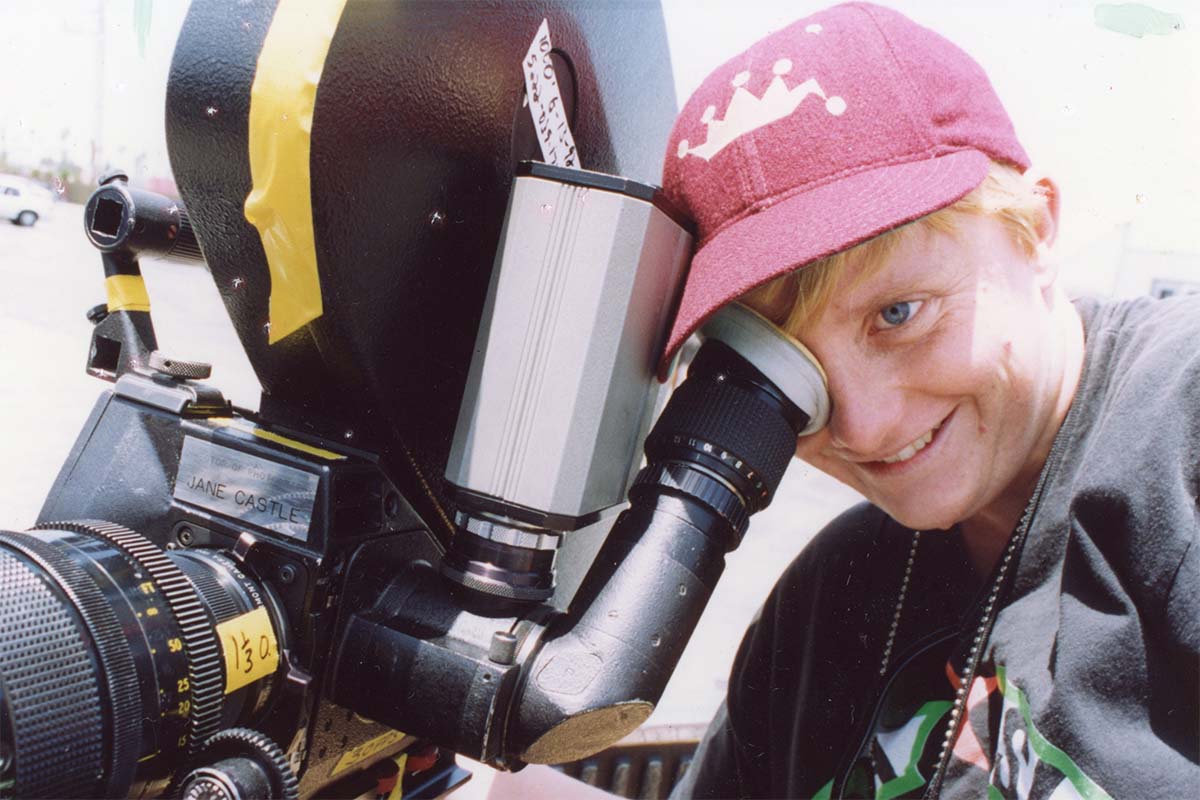 Jane Castle ACS
Jane Castle ACS
Acclaimed cinematographer Jane Castle ACS (who became the second woman to gain accreditation from the Australian Cinematographers Society in 1993: read more here) also turned to directing on her latest feature – a documentary about her trailblazing filmmaker mother Lilias Fraser, which was selected for Sydney Film Festival in 2021.
Jane Castle ACS: When the Camera Stopped Rolling spans six decades of cinematography from my mother’s (Lilias Fraser’s) first film The Beach, which she shot single-handedly on a Kodak Special through the 40-odd movies she directed, to my feature and music video work in the 80s and 90s and my recent image-work for this film. That’s a lot of cameras: the Canon Super8; Paillard Bolex; Canon Scoopic 16; Arri ST; Arri SR; Arri BL 3; Arri 2C; MovieCam; Panavision; Canon 5D Mk2; Canon XC10; Canon 1DX Mk2; GoPro and more.
For most of the digital imagery I used my humble Canon 5D Mk2 and the Canon L-Series 24-70mm; 70-200mm; and 100mm Macro lenses. While its limited banding and latitude meant colourist Roen Davis had his work cut out for him, it gave us the luxury to allow the film to evolve organically over time as we wrote, edited and filmed concurrently over several years. The 5D’s gorgeous low depth of field and pristine lenses made up for those limitations and the 1080 format (as opposed to 4K) just meant I had to get the framing right first go, a kind of discipline I liked.
I also borrowed a Canon 600mm plus Canon 1DX one weekend from Sun Studios to capture some spectacular waves and a friend lent me his Canon XC10 and a Zhiyun Crane 2 gimbal for the final scene which tracks the last day of Lilias’ life in gripping, slow-motion point-of-view. Justine Kerrigan ACS also lent us her talent one day with a Panasonic EVA1 for a gorgeous dawn scene. I’m proud that even without the flashiest of cameras we managed to create a stunningly beautiful film that’s winning cinematography awards – as Lilias always loved saying, “It’s the vision that counts!”
Visit When the Camera Stopped Rolling website here to find out where to watch.
NOT FROM THE CAMERA DEPT?
Here are two key terms that will come up:
- Lens: There is the camera itself and then a lens – also referred to as ‘glass’. They can be spherical or anamorphic and can be zoom or a ‘prime lens’, which has a fixed focal length (meaning you can’t zoom in or out). There are pros and cons to each. They are purchased separately – in fact they can be a completely different brand to the camera. Additionally filters – in conjunction with lenses – can be used to alter the exposure, colour and more. Productions will also typically hire cameras and lens kits.
- mm: The focal length of the lens is usually represented in millimetres or ‘mm’. The smaller the number, the shorter the focal length and the wider the field of view. The bigger the number, the longer the focal length and the narrower the field of view.

What to read next
Hear direct from the cinematographers of Australian film, television, documentary and web series as they break down what they filmed with and why.
17 Feb 2021
Caris Bizzaca